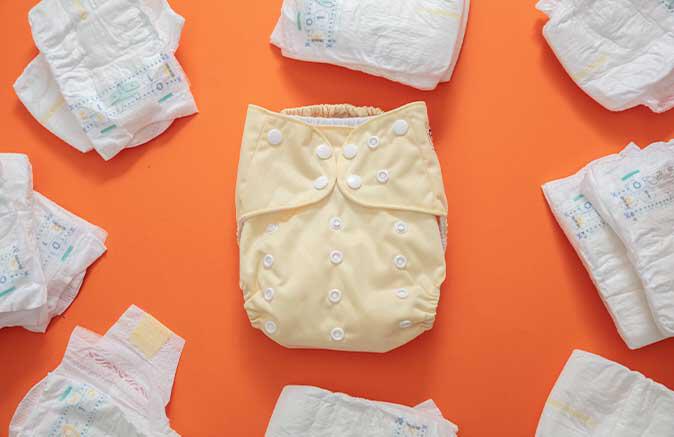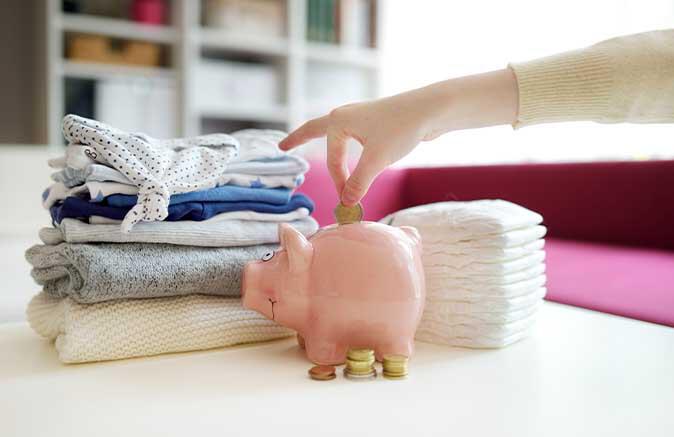Settling the Diaper Debate: A Handy Guide to Cloth vs. Disposables
Here at Savvy, all featured products are thoughtfully handpicked by our section editors. When you purchase something from our links, we may earn an affiliate commission. One last note — any items listed below are in-stock with accurate pricing as of time of publication.
Key Takeaways:
- A 24-30-count cloth diaper stash can cost up to $600 initially, with about $200 extra in laundry-related costs per year. However, cloth diapers are a one-time cost if you keep them in good shape.
- Budget disposable diapers can be as low as $0.10 each, but expect to spend $1,000 or more on diapers until your little one reaches the potty training stage.
- Cloth diapers require an extra two or three loads of laundry each week but keep diapers out of landfills, while disposables spare extra washes but create more waste.
- Natural fibers in cloth diapers can reduce skin irritation, while disposables' super absorbent core can keep babies dry longer.
Parents have to make tons of choices throughout their child's life, right down to what type of diaper is best for them. Cloth and disposable diapers both have pros and cons, but there's no right or wrong choice. Ultimately, the type you choose will meet your preferences for comfort, style, convenience, cleanup, and price.
We break down the key features of cloth diapers vs. disposables to help you on your quest for the ideal diaper for your baby. Consider this your blowout-free guide to mastering diaper duty:
Save big on your little one’s diapers with these top baby brands:

Comparing Cloth Diapers vs. Disposables
Cloth and disposable diapers differ in several ways that can affect your budget and laundry routine. Here's what you need to know about each to fully prepare yourself for every diaper change.
Types of Cloth and Disposable Diapers
If you're not already familiar with diapering a baby, you might be surprised by how many options are on the shelves. Keep reading and we’ll decode the most common cloth and disposable styles so you can treat your baby's bum without busting your budget or disrupting your cleaning routine.
Types of Cloth Diapers
Various cloth diaper styles balance cost, absorbency, and laundry workload differently. Knowing the types can help you pick a system that fits your budget and tolerance for mess:
- Flats: Flat cloth diapers are the most common and basic, which usually also makes them the most affordable. They include single layers of material you fold to size, and they usually need an additional waterproof cover.
- Prefolds: Prefolds are smaller, pre-sewn flats with an extra layer down the center for more absorbency. They're still budget-friendly, but require a cover and manual folding.
- Fitteds: These contoured diapers have snaps or Velcro for a secure fit, making them ideal for overnight absorbency. They look and feel a lot like disposable diapers but are reusable.
- All-in-Ones: Also known as AIOs, these diapers are among the most expensive types of cloth diapers, but they have an absorbent and waterproof layer sewn together to reduce messy leaks.
- Pocket Diapers: Pocket diapers have a waterproof shell and a built-in pocket for an absorbent insert. These usually carry a mid-range price tag and can be quicker to put on, but you'll need to stuff and unstuff them before every wash.
- All-in-Twos or Hybrids: AI2s have removable inserts like a pocket diaper, but the insert snaps inside the diaper's reusable shell. This lets you swap inserts when dirty and reuse the cover to reduce laundry loads.
- Swim and Training Cloth Diapers: Cloth diapers made for swimming and potty training are lightweight and usually designed to pull on and off.
Types of Disposable Diapers
Not all disposable diapers are created equal; their materials, absorption abilities, and special-use designs can determine your monthly spend and the amount of trash you haul to the curb.
- Standard Disposables: These are typical diapers you can find in most grocery stores and big-box retailers. They're the cheapest per diaper, but usually have the highest landfill impact.
- Premium Disposables: Premium disposables have the same basic diaper construction as standard disposables but may offer upgrades like stretchier tabs and wetness indicators. They cost more, but typically fit better and reduce leaks.
- Plant-Based Disposables: For eco-conscious parents, plant-based disposables use chemical-free processing and have partially bio-based cores to be gentler on skin and easier on the environment. However, they can be as much as 50% more expensive than standard disposables.
- Overnight Diapers: Overnight disposable diapers have extra absorbency designed to keep babies and toddlers dry throughout the night, usually for up to 12 hours.
- Swim and Training Pants: Disposable swim and training diapers usually pull on and off easily for quick swim changes and potty training. Swim diapers have waterproof shells that don't absorb pool water, while training pants tend to have fun designs that mimic "big kid" underwear.

Upfront and Ongoing Costs
Think of diapering costs in two parts: first, there's the initial cash you lay out when stocking up for a newborn, followed by the ongoing costs to consider as you keep your little one clean and comfortable through the stages of diapering. Cloth diapers require a bigger upfront investment, but ongoing costs aren't quite as steep. Meanwhile, disposables aren't usually as costly to start with, but you'll have to keep buying them until your baby’s ready to ditch their diapers.
Cloth Diaper Costs
If you go the cloth diaper route, you'll need to stock up on several diapers to start with. A workable rotation of 24-30 diapers works for most parents who wash every other day. A full set can cost anywhere from around $150 to $600 depending on the style and brand you choose. Budget pocket brands, for example, list for around $7-$10 a piece, while premium AIOs can cost closer to $25-$30 each.
Aside from buying the diapers themselves, you'll need to account for the water, energy, and detergent extra your diaper washes will use. According to Money Digest, the average load of laundry at home costs about $1.37. With cloth diapers, you may need to add two or three extra loads per week — about $4 weekly or $200 more annually than you might pay otherwise.
The upside: If you keep cloth diapers in good shape, you can hang onto them for future siblings.
Disposable Diaper Costs
You only need to buy disposable diapers as needed, and, like cloth diapers, you'll need a beginning stockpile to prepare for a baby. But you'll also need to keep buying them for as long as your baby needs diapers (which can be anywhere from 18 months to three years, on average).
Low-cost diapers tend to cost around $0.10-$0.12 each, while premium diapers are about double to triple that amount. If you pick up plant-based diapers, you can expect to pay around $0.40-$0.60 per diaper. Depending on how many diapers your baby uses per day and the type of disposable diaper you choose, you could spend an average of $1-$7 per day on diapers, or $365-$2,555 a year.
Once your little one reaches potty training age, your costs could drop to about $25-$90 monthly, depending on how often they have accidents.
Convenience, Time, and Mess Management
Cloth diapers tend to take more planning than disposables because they need laundering multiple times per week, and you'll need to make sure you have enough stocked while you clean and dry soiled ones (not to mention a place to store all that smelly fabric until the next wash). But cloth diapers can be a bit less convenient when you're out of the house, since you'll need to figure out where and how to rinse off the diaper until you can pop it in the washing machine. A portable, handheld diaper sprayer that attaches to a toilet and can fit into your diaper bag can make the mess more manageable.
Don't forget that, depending on the type of cloth diapers you buy, you may also spend time stuffing and unstuffing inserts after washes or before each diaper change.
Disposables cut down on cleanup significantly, only requiring a trash can to get rid of the mess (although you may want to invest in a diaper pail to keep odors from infiltrating your home!). But you'll also have more waste to get rid of come trash day.
Skin Health and Comfort
You want your baby's skin to stay smooth and comfortable in whatever type of diaper you choose, and that usually depends more on their skin sensitivity than whether they use cloth or disposable diapers. Some parents prefer the natural fibers of a cloth diaper compared to the absorbent polymers that disposable diapers use to keep babies dry. Some disposables can be gentler than others, though, like those made without chlorine and organic cotton.
As for comfort, cloth diapers often feel less bulky, and you can usually fine-tune the fit with adjustable snap or hook-and-loop closures. Many disposable diapers also have adjustable straps for a leakproof fit, but their more rigid outer layers can sometimes be stiffer around the legs.
Environmental Footprint
Many parents understandably don’t stop to think about the environmental impact of their little one’s diapers. Since you don't dispose of cloth diapers, they won't take up landfill space the more than 18 billion disposables that end up in landfills each year. But there's a tradeoff: all that rinsing and laundering adds up to significantly more water and energy being used with cloth diapers. Still, disposables have a longer-lasting impact because they decompose slowly, and they use lots of raw materials to produce and transport, including wood and fossil fuels.
Tips for Choosing What Fits Your Life (and Budget)
Still not sure whether cloth diapers or disposables are best for your baby? Here are a few tips to help you decide:
- Weigh lifestyle factors: If you're often on the go or rely on daycare, disposables may be more convenient. Cloth makes sense if you have wiggle room for extra laundry loads and a washer and dryer at home or access to a wash-and-fold service.
- Stack money-saving hacks: Buy cloth diapers in bundles or gently used lots to reduce your upfront cost. For disposables, join warehouse club memberships, like Costco or Sam's Club, for deals on bulk boxes, or sign up for autoship plans with built-in discounts.
- Use cloth AND disposables: You don't necessarily have to stick with one or the other if you like the perks of both! For example, use cloth diapers at home for daytime changes, then switch to disposables overnight or on road trips.
- Try before you invest: Borrow or rent a cloth diaper set so you can test out cloth diapering before stocking up. If it doesn't suit your baby or schedule, you'll avoid wasted costs.
